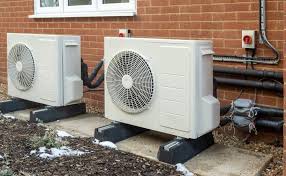Air source heat pumps (ASHPs) are increasingly popular for both heating and cooling residential and commercial buildings. They are known for their energy efficiency and eco-friendly operation, making them a great alternative to traditional heating systems like furnaces and boilers. This article will explore How Does Heat Pump Work, their components, and their benefits.
What is an Air Source Heat Pump?
How Do Air Source Heat Pumps Work is a device that transfers heat from the outside air into a building for heating or removes heat from the building for cooling. They can work efficiently even in cold weather, making them a versatile option for various climates. Unlike conventional heating systems that generate heat through combustion or electrical resistance, heat pumps move heat from one place to another.
The Basic Principle of Operation
Air source heat pumps operate on the same basic principle as refrigerators and air conditioners. They use a refrigeration cycle to transfer heat. The cycle involves four main components: the evaporator, compressor, condenser, and expansion valve.
Evaporator
The evaporator is located outside the building and is responsible for absorbing heat from the outside air, even in colder temperatures. It contains a refrigerant that evaporates at low temperatures, allowing it to absorb heat efficiently. As the outside air passes over the evaporator coils, the refrigerant inside absorbs the heat and turns from a liquid into a gas.
Compressor
The gaseous refrigerant is then pumped into the compressor, which increases its pressure and temperature. This step is crucial because it allows the refrigerant to release its heat effectively in the next stage of the cycle. The compressor is typically powered by electricity and plays a key role in the efficiency of the heat pump.
Condenser
Next, the high-pressure, high-temperature gas flows into the condenser, which is usually located inside the building. Here, the refrigerant releases its heat to the indoor air, warming the space. As it loses heat, the refrigerant condenses back into a liquid.
Expansion Valve
Finally, the liquid refrigerant passes through the expansion valve, where its pressure decreases. This drop in pressure causes the refrigerant to cool, making it ready to return to the evaporator and repeat the cycle. This closed-loop system allows the heat pump to continue transferring heat efficiently.
Heating vs. Cooling Mode
Air source heat pumps can operate in both heating and cooling modes. In heating mode, the cycle works as described above, transferring heat from the outside air into the building. In cooling mode, the process is reversed: the heat pump extracts heat from the indoor air and releases it outside. This dual functionality makes ASHPs versatile and useful year-round.
Benefits of Air Source Heat Pumps
Energy Efficiency
One of the biggest advantages of air source heat pumps is their energy efficiency. They can produce more energy in heat than they consume in electricity. For instance, a heat pump can have a coefficient of performance (COP) of 3 or higher, meaning that for every unit of electricity consumed, it can transfer three or more units of heat.
Environmental Impact
ASHPs are a more environmentally friendly option compared to fossil fuel heating systems. They reduce greenhouse gas emissions and can be powered by renewable energy sources, such as solar or wind. This makes them an attractive option for those looking to minimize their carbon footprint.
Cost Savings
While the initial investment for an air source heat pump may be higher than traditional systems, the long-term savings on energy bills can be significant. Additionally, many governments and utilities offer incentives, tax credits, or rebates for installing energy-efficient systems, which can help offset initial costs.
Low Maintenance
Air source heat pumps generally require less maintenance than conventional heating systems. Regular checks and filter replacements are typically sufficient to keep the system running efficiently.
Space Saving
ASHPs require less space compared to traditional heating systems. They can be installed outside the building, freeing up valuable indoor space that would otherwise be used for a furnace or boiler.
Considerations When Choosing an Air Source Heat Pump
While air source heat pumps have many advantages, there are some factors to consider:
Climate Suitability
Although ASHPs can work efficiently in a range of temperatures, their performance may decrease in extremely cold climates. However, modern systems are designed to operate effectively at lower temperatures, making them suitable for most regions.
Initial Cost
The upfront cost of purchasing and installing an air source heat pump can be higher than traditional heating systems. It’s essential to evaluate your budget and consider long-term savings on energy bills.
Proper Sizing
An appropriately sized heat pump is crucial for optimal performance. An undersized system may struggle to heat or cool your space adequately, while an oversized unit can lead to inefficiencies and increased wear and tear. Consulting a professional for sizing is recommended.
Installation Quality
The efficiency and longevity of your heat pump largely depend on the quality of the installation. It’s essential to hire a qualified HVAC technician to ensure that the system is installed correctly and operates efficiently.
Conclusion
Air source heat pumps represent an innovative and efficient solution for heating and cooling homes and buildings. Their ability to transfer heat instead of generating it, combined with their energy efficiency and eco-friendly benefits, make them an appealing choice for many homeowners. As technology continues to advance, air source heat pumps will likely become even more effective and widely adopted. Whether you are considering upgrading your heating and cooling system or looking for a more sustainable option, air source heat pumps are worth considering for their long-term advantages.
